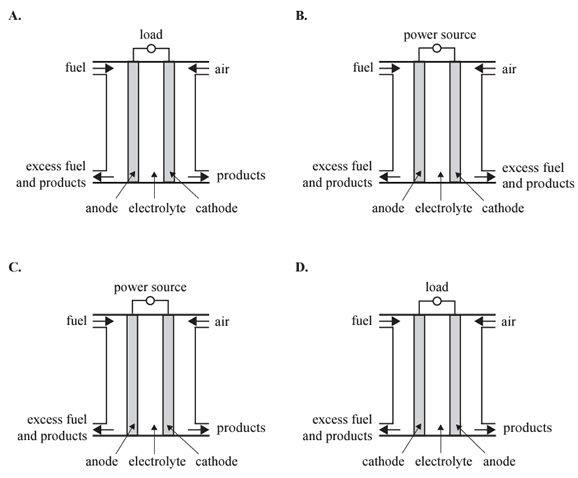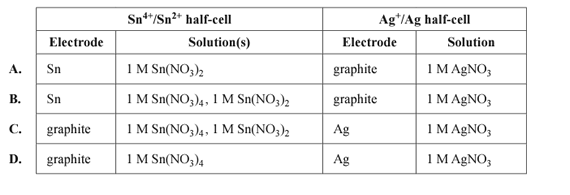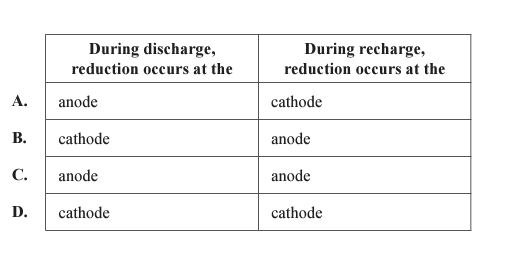1) Consider the following characteristics of electrolytic cells and galvanic cells.

Solution

2) Galvanic cells and fuel cells have
A. the same energy transformations and both are reversible.
B. the same energy transformations and both produce heat.
C. different energy transformations but galvanic cells produce electricity.
D. different energy transformations but fuel cells use porous electrodes.
Solution

3) Unlike direct combustion of fuel, fuel cells
A. can be recharged.
B. do not produce greenhouse gases.
C. require electrical energy to overcome the activation energy barrier.
D. do not have direct contact between the oxidising and reducing agents.
Solution

4) The discharge reaction in a vanadium redox battery is represented by the following equation.
VO2+(aq) + 2H+(aq) + V2+(aq) → V3+(aq) + VO2+(aq) + H2O(l)
When the vanadium redox battery is recharging
A. H+ is the reducing agent.
B. H2O is the oxidising agent.
C. VO2+ is the reducing agent.
D. VO2+ is the oxidising agent.
Solution

5) A student wants to investigate a galvanic cell consisting of Sn4+/Sn2+ and
Ag+/Ag half-cells. Which one of the following combinations of electrodes and solutions will produce an operational galvanic cell?

Solution
6) The equipment below was set up by a student

Which one of the following is correct?
A. In the beaker, the reaction between Zn(s) and Co2+(aq) produces 0.48 V.
B. In the beaker, chemical energy stored in the reactants is converted to heat energy.
C. In the beaker, the concentration of ions increases because Zn(s) loses 2e−.
D. In the beaker, a voltage of greater than 0.42 V must be applied to Zn(s) so that it reacts with Mn2+(aq).
Solution

7) Lithium ion batteries are used in a range of electronic devices, including mobile phones. The discharge reaction for this type of battery is
LiC6(s) + CoO2(s) → C6(s) + LiCoO2(s)
a. Which of the following is correct about lithium batteries?

Solution
b. Which one of the following statements about lithium ion batteries is correct?
A. During recharge, LiCoO2 is formed at the negative electrode.
B. During discharge, Li+ ions move towards the positive electrode.
C. Raising the battery temperature increases the rate of reaction, thereby increasing the battery life.
D. The battery operates as an electrolytic cell during discharge and as a galvanic cell during recharge.
Solution

8) Consider the following half-equations, which are not in standard electrode potential order.

The following is also known:
• I2 reacts with BrO3- and HBrO but not with HCrO4-.
• Br- reacts with HBrO but not with IO3-.
Platinum electrodes were used in each half-cell.
Which one of the following galvanic cells will produce the highest potential difference?
Solution
